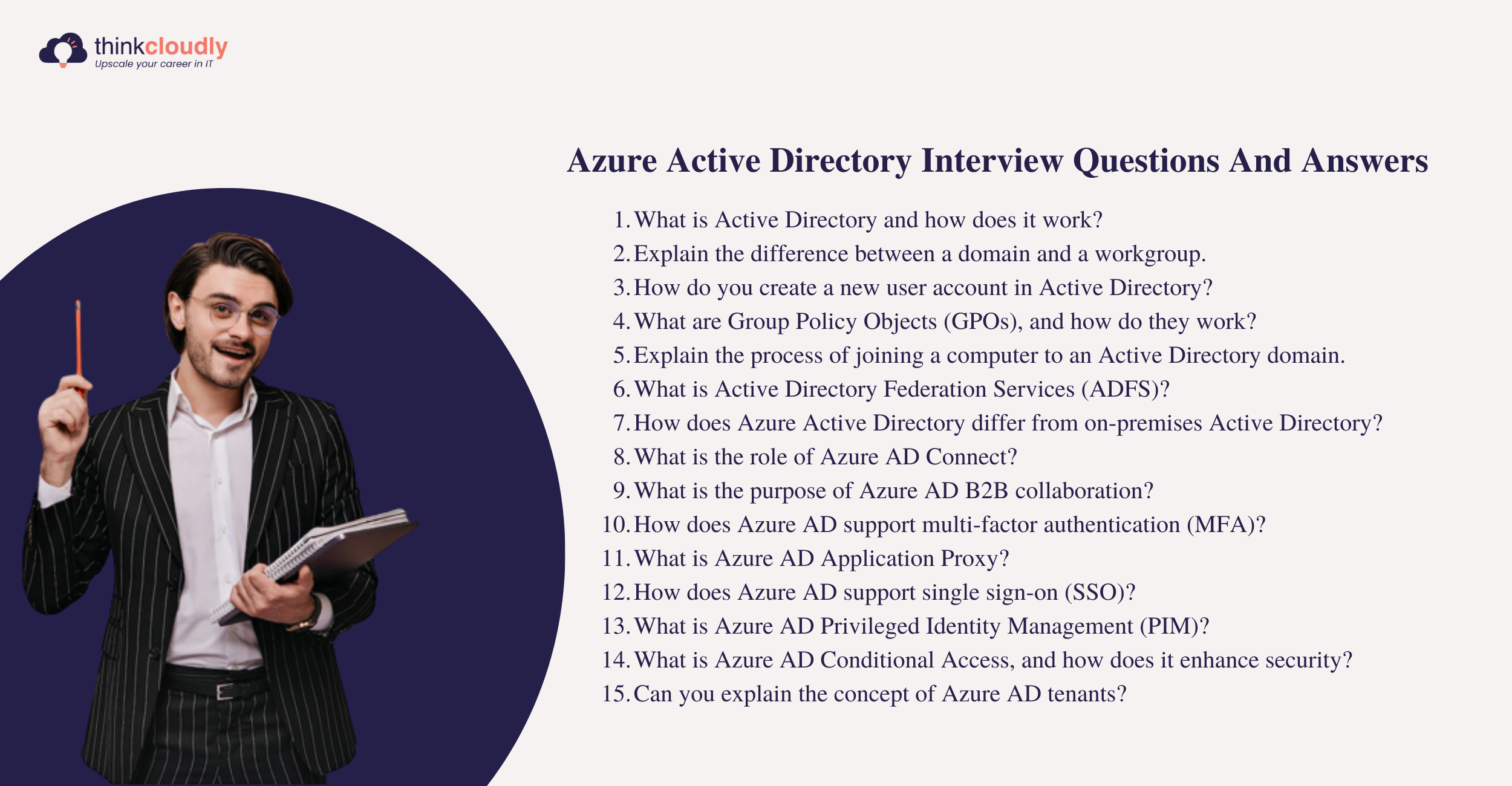Imagine you’re part of a multinational corporation with thousands of employees spread across different regions. Each employee requires access to company resources like shared drives, email systems, and internal applications. Managing user accounts and permissions manually would be a logistical nightmare, prone to errors and security vulnerabilities. This is where Active Directory steps in.
In this blog, we will not be focusing on the theoretical definition of Azure Active Directory instead we will be looking at explanatory Azure Active Directory interview questions and answers that can be your help in your interview.
Mastering Azure AD Interview Questions: Identity and Access Expertise
Preparing for an interview involving Azure Active Directory (Azure AD) requires familiarizing yourself with a range of pertinent Azure AD interview questions. These questions delve into topics like identity and access management, authentication methods, role-based access control, and integration with other Azure services. Azure AD interview questions aim to gauge your understanding of how to securely manage identities and enable seamless user access within Azure environments. By studying and practicing these questions, you’ll be better equipped to showcase your expertise in designing and implementing effective identity solutions using Azure AD. This preparation ensures you’re ready to discuss key concepts and practical scenarios that highlight your capability to contribute to identity and security management in the Azure ecosystem.
In preparation for your Azure Active Directory (Azure AD) interview, it’s crucial to familiarize yourself with a range of active directory questions and active directory technical questions. Azure AD interview questions often delve into the intricacies of managing identities, securing access, and optimizing Azure AD services. To excel in your interview, be well-prepared with comprehensive answers to commonly asked Azure Active Directory interview questions and answers. These Azure AD interview questions will assess your proficiency in identity and access management within the Azure ecosystem.
Azure Active Directory Interview Questions
 Question 1: What is Active Directory and how does it work?
Question 1: What is Active Directory and how does it work?
Answer: Active Directory is a directory service developed by Microsoft that provides a centralized database for managing and organizing network resources. It stores information about users, groups, computers, and other network objects. AD uses a hierarchical structure called the Directory Information Tree (DIT) and employs protocols like LDAP (Lightweight Directory Access Protocol) for communication between clients and the directory service.
Question 2: Explain the difference between a domain and a workgroup.
Answer: A domain is a logical grouping of computers, users, and resources that share a common security policy and trust relationship. It offers centralized administration, enhanced security, and single sign-on capabilities. In contrast, a workgroup is a collection of computers that are connected on a peer-to-peer basis, without a centralized authority for authentication or resource management.
Question 3: How do you create a new user account in Active Directory?
Answer: To create a user account in AD, follow these steps:
- Open the Active Directory Users and Computers console.
- Right-click on the desired organizational unit (OU) and select “New” > “User.”
- Fill in the user’s details, such as name, username, password, and group memberships.
- Click “Finish” to create the user account.
Question 4: What are Group Policy Objects (GPOs), and how do they work?
Answer: Group Policy Objects are containers that store policy settings for computer and user configurations in an Active Directory environment. GPOs are applied to organizational units (OUs) and control various aspects of system behavior, such as security settings, software deployment, and desktop customization. They work by enforcing policies on targeted computers and users, ensuring consistency and centralized management of configurations.
Question 5: Explain the process of joining a computer to an Active Directory domain.
Answer: To join a computer to an AD domain, perform the following steps:
- Right-click on “This PC” (Windows 10) or “My Computer” (older versions) and select “Properties.”
- Click on “Change settings” next to the computer name.
- In the “System Properties” window, select the “Computer Name” tab and click “Change.”
- Choose the “Domain” option, enter the domain name, and click “OK.”
- Provide credentials of a user with sufficient privileges to join the domain.
- Restart the computer for the changes to take effect.
Build Your Career as a
Azure Cloud Architect
- Live Projects
- Resume / Interview Preparation

Question 6: What is Active Directory Federation Services (ADFS)?
Answer: Active Directory Federation Services is a component of Windows Server that enables the secure sharing of identity information across organizational boundaries. ADFS allows users to authenticate to resources in a partner organization using their local credentials, eliminating the need for separate usernames and passwords. It employs industry-standard protocols like SAML (Security Assertion Markup Language) to facilitate secure authentication and authorization.
Question 7: How does Azure Active Directory differ from on-premises Active Directory?
Answer: While both Azure Active Directory and on-premises Active Directory serve the purpose of identity management, there are some key differences. Azure AD is a cloud-based service, accessible from anywhere, and primarily designed for managing identities in the cloud. On-premises Active Directory, on the other hand, is typically deployed within an organization’s private network and manages identities for on-premises resources.
Boost your earning potential with Azure expertise. Explore our certified Azure Courses for a high-paying career
- Explore Azure DevOps Certification
Question 8: What is the role of Azure AD Connect?
Answer: Azure AD Connect is a tool that facilitates the synchronization of on-premises Active Directory with Azure Active Directory. It enables organizations to extend their on-premises directory to Azure AD, ensuring a unified identity experience for users across cloud and on-premises environments.
Question 9: What is the purpose of Azure AD B2B collaboration?
Answer: Azure AD B2B collaboration allows organizations to securely share resources and collaborate with external users, such as partners or vendors. It enables the invited external users to authenticate and access specific resources in the organization’s Azure AD, while maintaining control over the access and permissions granted to them.
Question 10: How does Azure AD support multi-factor authentication (MFA)?
Answer: Azure AD provides built-in support for multi-factor authentication, which adds an extra layer of security to user sign-ins. Users are required to provide additional verification, such as a phone call, text message, or mobile app notification, in addition to their password, to prove their identity.
Question 11: What is Azure AD Application Proxy?
Answer: Azure AD Application Proxy allows organizations to securely publish on-premises web applications for remote access. It acts as a reverse proxy, enabling users to access the applications from anywhere, without the need for a VPN. It also provides additional security features, such as pre-authentication and conditional access policies.
Question 12: How does Azure AD support single sign-on (SSO)?
Answer: Azure AD enables single sign-on to various cloud applications and services. Users can sign in once to their Azure AD account and then access multiple applications without the need to provide credentials again. Azure AD uses industry-standard protocols like SAML, OAuth, and OpenID Connect to enable SSO.
Question 13: What is Azure AD Privileged Identity Management (PIM)?
Answer: Azure AD Privileged Identity Management is a service that helps organizations manage and control access to privileged roles in Azure AD and other Microsoft services. It allows organizations to limit and monitor the time and scope of administrative access, reducing the risk of unauthorized or unnecessary access to sensitive resources.
Question 14: What is Azure AD Conditional Access, and how does it enhance security?
Answer: Azure AD Conditional Access is a policy-based access control feature that allows organizations to enforce specific conditions for user access to applications and resources. It enables administrators to define access requirements based on factors like user location, device compliance, and risk level. By implementing Conditional Access policies, organizations can strengthen their security posture and ensure that access is granted only under the desired conditions, reducing the risk of unauthorized access.
Question 15: Can you explain the concept of Azure AD tenants?
Answer: An Azure AD tenant is a dedicated instance of Azure AD that represents an organization’s identity and access management service. It is unique to each organization and contains information about users, groups, applications, and other resources. Within an Azure AD tenant, administrators can define policies, manage identities, and control access to various Azure services and applications. Tenants can be associated with a specific Azure subscription or span across multiple subscriptions, depending on the organization’s needs.
Conclusion
Congratulations! You’ve made it through our engaging exploration of Active Directory interview questions. By mastering the technical aspects of Active Directory, you’ll be well-prepared to tackle any interview or expand your knowledge in this crucial area of IT. Remember, continuous learning is key, so stay tuned for more exciting blogs that will keep you one step ahead in the ever-evolving world of technology. Happy learning, and see you soon!
Wants to deep dive into the cloud. Refer to our more blogs:
• Top 15 AWS Security interview questions and answers you need to know
• Most common AWS S3 interview questions and answers – 2024
• Top 50 Azure interview questions and answers – 2024
• 12 tips to pass the AWS cloud practitioner exam
• Top 10 tips for a great IT job interview










